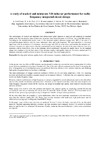Please use this identifier to cite or link to this item:
https://accedacris.ulpgc.es/jspui/handle/10553/46919
| Title: | A study of stacked and miniature 3-D inductor performance for radio frequency integrated circuit design | Authors: | Iturri, A. Goñi Del Pino, F. J. Khemchandani, S. L. García, J. González, B. Hernández Ballester, Antonio |
UNESCO Clasification: | 3307 Tecnología electrónica | Keywords: | Inductance Metals Silicon 3D imaging standars Integrated circuit design, et al |
Issue Date: | 2007 | Journal: | Proceedings of SPIE - The International Society for Optical Engineering | Conference: | Conference on VLSI Circuits and Systems III | Abstract: | The performance of stacked and miniature three-dimensional spiral inductors is analyzed and compared to standard planar coils. For this purpose, nine of these new structures have been fabricated in a 0.35-mu m four-metal SiGe process. According to the measurement results, some of the proposed stacked inductors occupy only 48% of the area of a conventional planar inductor with the same inductance value and work frequency. The area reduction is even more significant with the miniature 3-D structures, which occupy only 22% in some cases, and translate the inductor self-resonance frequency to higher values than the conventional stacked inductors. In spite of this area reduction, these new structures employ metal levels close to the substrate, which significantly degrades the quality factor. So the standard planar coils continue to be the best choice if the designer requires high-quality inductors. However, stacked and 3-D miniature structures could be a better solution if the area saving is the circuit major priority. | URI: | https://accedacris.ulpgc.es/handle/10553/46919 | ISBN: | 978-0-8194-6718-8 | ISSN: | 0277-786X | DOI: | 10.1117/12.721913 | Source: | Proceedings of SPIE - The International Society for Optical Engineering[ISSN 0277-786X],v. 6590 (65901C) |
| Appears in Collections: | Actas de congresos |
SCOPUSTM
Citations
1
checked on Jun 8, 2025
Page view(s)
62
checked on Jul 22, 2023
Download(s)
163
checked on Jul 22, 2023
Google ScholarTM
Check
Altmetric
Share
Export metadata
Items in accedaCRIS are protected by copyright, with all rights reserved, unless otherwise indicated.
